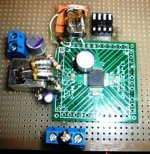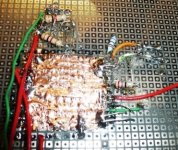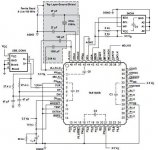Interesting, - the power supplies you are modding are the analog power for the left & right channels (AVCC_L & R) - these are known to have very sensitive requirements re PS & anything that improves this makes a significant improvement in the sound.
I'm not so sure about your use of elco & bypassed cap at this pin - the smd part would have a lower inductance which is desirable in PS decoupling.
What's really needed is to put bypass caps on all PS pins & feed these pins with clean PS in groupings that will not interact or interfere with the optimal working of the DAC. This is what I'm hoping to do on my tweakers board for the ES9018 chip. I decided that this was more sensible than trying to mod a TP board for better power distribution.
If the battery has a very low internal impedance then it's capable of delivering all the current needed when requested & it's AC behaviour should be exemplary when feeding directly to chip or with cap buffer. What battery are you using?
I'm not so sure about your use of elco & bypassed cap at this pin - the smd part would have a lower inductance which is desirable in PS decoupling.
What's really needed is to put bypass caps on all PS pins & feed these pins with clean PS in groupings that will not interact or interfere with the optimal working of the DAC. This is what I'm hoping to do on my tweakers board for the ES9018 chip. I decided that this was more sensible than trying to mod a TP board for better power distribution.
If the battery has a very low internal impedance then it's capable of delivering all the current needed when requested & it's AC behaviour should be exemplary when feeding directly to chip or with cap buffer. What battery are you using?
Would be interesting trying alternatives to the polymer caps on the Buffalo32s analogue decoupling😉
When I was modding the original Buffalo I tried those Sanyo SEP's (also polymer) in various places, some places the sound really went poor imo yet certain places they worked very well.
I tried SEPS on the IVY, after a week I ripped them out and put panny FM back in
When I was modding the original Buffalo I tried those Sanyo SEP's (also polymer) in various places, some places the sound really went poor imo yet certain places they worked very well.
I tried SEPS on the IVY, after a week I ripped them out and put panny FM back in
Leo, SEPs are ultra low esr caps & should be good on the digital supply bypassing duties but not necessarily good for signal decoupling. Where did you find they worked & where did they sound worse?
jkeny said:Leo, SEPs are ultra low esr caps & should be good on the digital supply bypassing duties but not necessarily good for signal decoupling. Where did you find they worked & where did they sound worse?
I know all about low ESR, I've been faffing about long enough😀
Both SVP (as used on Buffalo32s including analogue) and SEP are polymer ultra low ESR, I asked about polymer and had totally different opinions on them if used on analogue supplies.
Only way to know is for the individual to try a few alternatives and compare
For the SEP's in the original Buffalo I liked them on the oscillator decoupling and the dacs main decoupling (not the AVCC L&R)
I didn't like them for the AVCC and especially not the IVY
Leo, didn't mean to come across sounding patronising, what I meant was that SEP are ultra low esr (=< 10 mohm) whereas SVP are not (can be up to 200mohm depending on uF/V rating). What uF/V rating SVP are used on the Buffalo?
Edit: Looked at the Buffalo photo & it looks like SVP 100uF/20V caps - esr 24mohm equivalent SEPC cap 270uf/16V - esr 11mohm - maybe not a huge difference but who knows?
As expected the digital supplies benefited most from this lower esr cap.
One of the tips I picked up along the way - to provide separate 3.3V supplies to the bottom padring from the top padring dig supply so the clock feed does not have any perturbating activity to contaminate it.
Edit: Looked at the Buffalo photo & it looks like SVP 100uF/20V caps - esr 24mohm equivalent SEPC cap 270uf/16V - esr 11mohm - maybe not a huge difference but who knows?
As expected the digital supplies benefited most from this lower esr cap.
One of the tips I picked up along the way - to provide separate 3.3V supplies to the bottom padring from the top padring dig supply so the clock feed does not have any perturbating activity to contaminate it.
jkeny said:What battery are you using?
2x POWERFIT S312/7 ah (+/-12V)
4x HQ BAT-LEAD 7 ah (6V)
POWERFIT S312/7 battery - internal impedance 67 mohm is probably why the ac behaviour is not as good as it could be!
jkeny said:I'm not so sure about your use of elco & bypassed cap at this pin - the smd part would have a lower inductance which is desirable in PS decoupling.
Maybe. First i'll tried the Panasonic FM (ultra low ESR) paralleled to the ceramic caps C1 and C2. That was to heavy. Got edges, irritating. The Panasonics are not suitable in analog section. This solution is just a tryout. Sounds better for me then the ceramics. I believe that anything is better then the ceramic cap's. Its personal taste, just try and let we share the experiences. As you said, this is a very sensitive point.
jkeny said:Leo, didn't mean to come across sounding patronising, what I meant was that SEP are ultra low esr (=< 10 mohm) whereas SVP are not (can be up to 200mohm depending on uF/V rating). What uF/V rating SVP are used on the Buffalo?
Edit: Looked at the Buffalo photo & it looks like SVP 100uF/20V caps - esr 24mohm equivalent SEPC cap 270uf/16V - esr 11mohm - maybe not a huge difference but who knows?
As expected the digital supplies benefited most from this lower esr cap.
One of the tips I picked up along the way - to provide separate 3.3V supplies to the bottom padring from the top padring dig supply so the clock feed does not have any perturbating activity to contaminate it.
Don't worry about it, I wasn't offended which is why I added the 😀
Polymer is totally different to whats used in other electrolytic caps, the sound when using them isn't the same, to some it can sound boring, others say it lacks colouration
The output impedance of the regs I use is less than 0.001R , using ultra low ESR caps on either analogue or digital don't seem to cause much difference, not as much as the material type in the capacitor used
Just nearly finished the TAS1020B USB streaming controller on protoboard & thought I'd post some pics. I'm using it as a test bed for ideas/techniques before I tackle the Sabre DAC protoboard.
I have two ground planes on this - the bottom of the protoboard is a solid analogue ground plane & the bottom of the matrix board is a copper foil filled digital ground plane. There is also a small copper clock ground plane under the crystal & PLL components. All gnd planes are directly connected under the chip although the TAS1020B datasheet recommends to use a ferrite bead to join the clock gnd plane to the analogue ground plane.
Small X5R 0.1uF caps are placed close to the chip but could go closer. SEPC cap with bypass on analog crystal supply & SEPC cap on across PS lines.
I should be ready to attack the Sabre DAC tweakers board shortly.
Any recommendations/improvements I could make?
I have two ground planes on this - the bottom of the protoboard is a solid analogue ground plane & the bottom of the matrix board is a copper foil filled digital ground plane. There is also a small copper clock ground plane under the crystal & PLL components. All gnd planes are directly connected under the chip although the TAS1020B datasheet recommends to use a ferrite bead to join the clock gnd plane to the analogue ground plane.
Small X5R 0.1uF caps are placed close to the chip but could go closer. SEPC cap with bypass on analog crystal supply & SEPC cap on across PS lines.
I should be ready to attack the Sabre DAC tweakers board shortly.
Any recommendations/improvements I could make?
Attachments
This TAS1020B board will act as my USB to I2S converter - I want to be able to plug in various I2S DACs into this (TDA1543, TDA1387, ES9018). So I'm searching for a robust, cheap 9 pin (5 gnd lines interleaved with 4* I2S signal lines) plug & socket system i.e no cable between them as I want a short distance for the I2S signals to travel
Any ideas?
Edit: I like the 90 degree Molex headers but the sockets into which these plug all require a cable - I wanted the socket to also have 90 degree pins out the back that could be soldered directly to the matrix board
Any ideas?
Edit: I like the 90 degree Molex headers but the sockets into which these plug all require a cable - I wanted the socket to also have 90 degree pins out the back that could be soldered directly to the matrix board
@Jkeny
1. What's the status on the firmware side? Are U still planing to use the M-Audio Transit code?
2. How about slaving the 1020 to a master?
3. Any ideas about USB isolation?
1. What's the status on the firmware side? Are U still planing to use the M-Audio Transit code?
2. How about slaving the 1020 to a master?
3. Any ideas about USB isolation?
Yep, still using the Transit code (I take it nobody came back to you on the ALSA forum re the Alsa log showing asynchronous operation of this code?)
How do you mean slaving to a master? Does this not require a different firmware?
I haven't given much thought to USB isolation as it is not a simple fix - see the attached schematic. The TAS chip uses an external PS rather than the USB Vcc so this helps somewhat (I know the gnd is still a direct connection to the PC)
What I need are PCB to PCB connectors with a pitch of .01" & 90. Any ideas
Oops can't attach the schematic
How do you mean slaving to a master? Does this not require a different firmware?
I haven't given much thought to USB isolation as it is not a simple fix - see the attached schematic. The TAS chip uses an external PS rather than the USB Vcc so this helps somewhat (I know the gnd is still a direct connection to the PC)
What I need are PCB to PCB connectors with a pitch of .01" & 90. Any ideas
Oops can't attach the schematic
1.
The only comment I received was, that if U do recordings the transit "should" run in async mode.
In this case it runs as a source and will set the scene. To me this wasn't really a convincing feedback on the subject. No word on the playback part.
2. Master-clock: No idea if it requires new firmware? You're in the lead here. I'd expected
that this feature went into your design-specs.
3. Connections: most of them are soldered at pins or wired to terminals (Buffalo).
The only comment I received was, that if U do recordings the transit "should" run in async mode.
In this case it runs as a source and will set the scene. To me this wasn't really a convincing feedback on the subject. No word on the playback part.
2. Master-clock: No idea if it requires new firmware? You're in the lead here. I'd expected
that this feature went into your design-specs.
3. Connections: most of them are soldered at pins or wired to terminals (Buffalo).
1. Agreed, soundcheck not really a convincing reply from the Alsa forum.
2. I'm still a bit confused about the Master clock:
On the one hand, according to the datasheet it says a register setting has to be changed to allow the TAs chip use a master clock. This then implies a change to the firmware & I don't have the source for the transit firmware. Even if the correct bit could be identified in the firmware that mapped to this register & a change made to the firmware's binary object code, I'm told that the firmware has a checksum on it which would also have to be changed.
On the other hand, I see that the TAS evaluation board has a jumper that allows use of an external clock so no changing of firmware needed in this case.
So I'm confused & have left it as a topic for future investigation! Any help would be appreciated.
3. I wanted the ability to plug in different DAC boards to this TAS board & different I/V stage boards to the DAC so some good pcb-to-pcb connectors are what's needed. I've found Hirose connectors but they seem not to come in .1" pitch
2. I'm still a bit confused about the Master clock:
On the one hand, according to the datasheet it says a register setting has to be changed to allow the TAs chip use a master clock. This then implies a change to the firmware & I don't have the source for the transit firmware. Even if the correct bit could be identified in the firmware that mapped to this register & a change made to the firmware's binary object code, I'm told that the firmware has a checksum on it which would also have to be changed.
On the other hand, I see that the TAS evaluation board has a jumper that allows use of an external clock so no changing of firmware needed in this case.
So I'm confused & have left it as a topic for future investigation! Any help would be appreciated.
3. I wanted the ability to plug in different DAC boards to this TAS board & different I/V stage boards to the DAC so some good pcb-to-pcb connectors are what's needed. I've found Hirose connectors but they seem not to come in .1" pitch
Seeing as though the other thread got locked 🙄 I'll post a pic of latest Buffalo32s mods here
I've replaced the onboard LT1763 regs 2 x Paul Hynes Z1703v3 shunts (XO and VD) and S17LN-1v2 series reg for the dacs core
Z1A-15 / Z1N-15 shunts to supply the VA +/- 15v
Sound so far is excellent😀
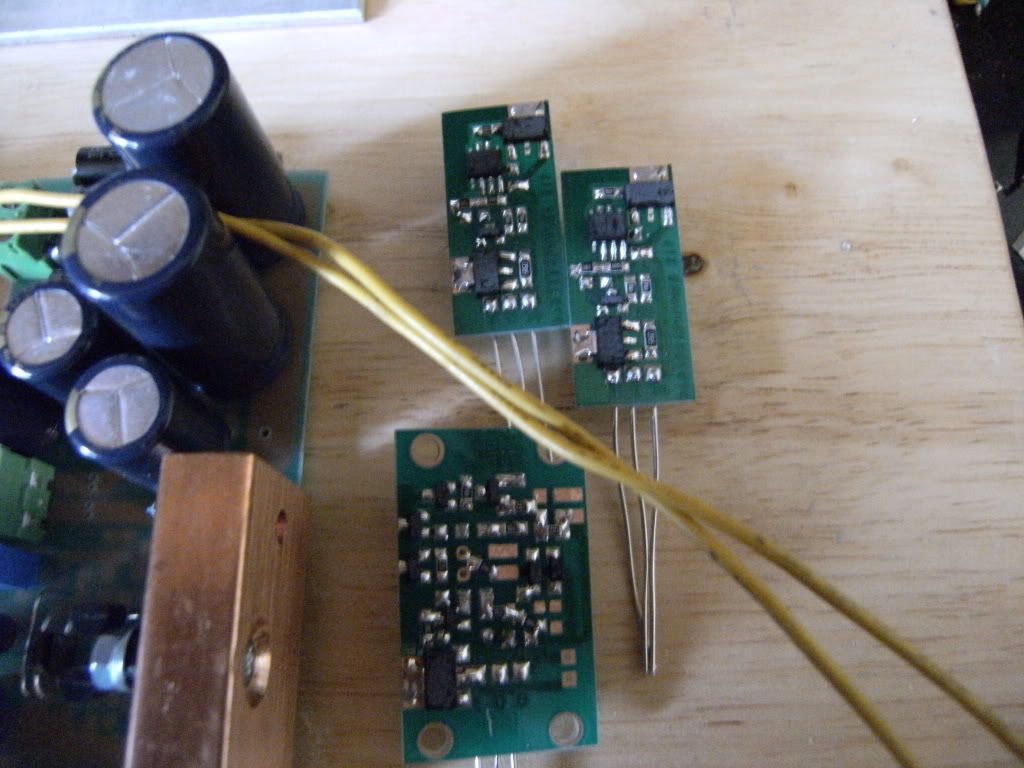
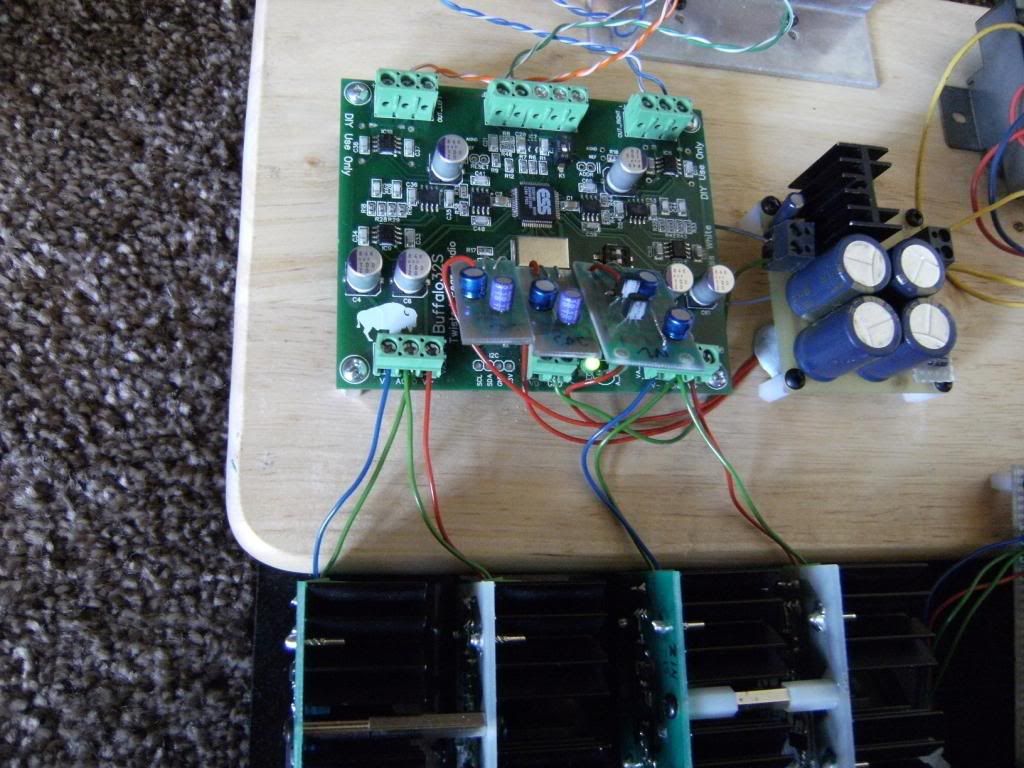
I've replaced the onboard LT1763 regs 2 x Paul Hynes Z1703v3 shunts (XO and VD) and S17LN-1v2 series reg for the dacs core
Z1A-15 / Z1N-15 shunts to supply the VA +/- 15v
Sound so far is excellent😀


Last edited:
I've replaced the onboard LT1763 regs 2 x Paul Hynes Z1703v3 shunts (XO and VD) and S17LN-1v2 series reg for the dacs core
Z1A-15 / Z1N-15 shunts to supply the VA +/- 15v
Sound so far is excellent😀
]
More PS mods, Leo - the Sabre seems to respond to better PS supplies on all it's stages 🙂 Remind us what PS mods you had done on this before (this is the 32 bit version, isn't it?)
Can you say what changes these PS mods brought just so others (me 😀) can evaluate the cost effectiveness of each one. For instance the core 1.2V PS mod - what effect?
At this juncture, the PS stages are probably more expensive than the stock Buffalo
 (jeez, I hope Hurtig & Kurt don't read this 🙁)
(jeez, I hope Hurtig & Kurt don't read this 🙁)Edit: In my own experiments, progress has been slow. I bought a couple of the ES9022 Vout DAC chips from ESS because I wanted to hear (or at least get a flavour) the sound of the Sabre technology. I need to iron out some issues before I can give an honest impression - some issues to do with PS & some with I2S. I'm troubleshooting the above TAS USB controller & modding a Musiland DAC so should have some reasonable comparisons soon 😀
Last edited:
As you know I fitted Paul Hynes regs on the original Buffalo, after being so impressed with the results on that dac I was very curious to see how well some performed with this one
I'm more than happy so far, its hard to explain exactly why it sounds better than before, performances come across more convincing
I replaced all three onboard regs at the same time so can't say for sure which one would be most effective.
The pcb is pretty delicate so I just wanted to get the lot done to reduce any chance of track damage
With the original Buffalo using ES9008 upgrading the AVCC L&R regs gave the biggest improvement followed by the VD 3v3 and the XO, the 1v2 gave a smaller but still noticeable improvement, as a guess the ES9018 based dac would be similar
One thing I did try before replacing the LT1763's was to compare a few different regulated psu's set to 5v, this is used as a pre reg for the 3 x onboard LT1763's.
I tried various LM317 based, ALW super reg, Teddy reg etc, the best IMO was a Paul Hynes PR3G2 adjustable series reg supply (which I now use with something else since the LT1763's was replaced)

Before the Paul Hynes Z1A-15 / Z1N-15 shunts I was using 2 x pairs of Burson discretes
Obviously the VA supply for the output stage has quite an effect and the easiest to compare supply wise
I'm more than happy so far, its hard to explain exactly why it sounds better than before, performances come across more convincing
I replaced all three onboard regs at the same time so can't say for sure which one would be most effective.
The pcb is pretty delicate so I just wanted to get the lot done to reduce any chance of track damage
With the original Buffalo using ES9008 upgrading the AVCC L&R regs gave the biggest improvement followed by the VD 3v3 and the XO, the 1v2 gave a smaller but still noticeable improvement, as a guess the ES9018 based dac would be similar
One thing I did try before replacing the LT1763's was to compare a few different regulated psu's set to 5v, this is used as a pre reg for the 3 x onboard LT1763's.
I tried various LM317 based, ALW super reg, Teddy reg etc, the best IMO was a Paul Hynes PR3G2 adjustable series reg supply (which I now use with something else since the LT1763's was replaced)

Before the Paul Hynes Z1A-15 / Z1N-15 shunts I was using 2 x pairs of Burson discretes
Obviously the VA supply for the output stage has quite an effect and the easiest to compare supply wise
- Status
- Not open for further replies.
- Home
- Source & Line
- Digital Line Level
- Buffalo Tweaking
